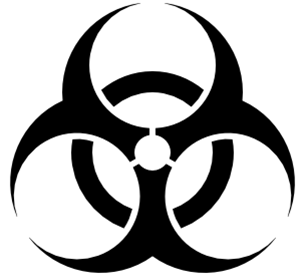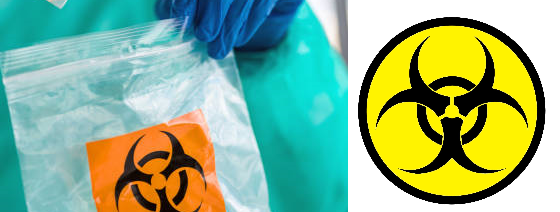Bioterrorism is an archaic and primitive practice of warfare that predates the development of the “Germ Theory of Disease” by Robert Koch. The Romans, ancient Greeks, the Chinese and the Persians used microbes and other biological agents including dead bodies as weapons of warfare against their enemies. The weaponization of these agents and their usage for warfare was largely used during the 14th – 19th century and even during World War I.
History has it that tribal wars fought in some parts of Europe and Americas were fought with earlier biological agents including human and animal feaces and even cadavers which opponents in battlefield used to poison and contaminate the food and water supply of their enemies in order to incapacitate them for battle. In 1346, biological warfare attack was used when the Tartars flung cadavers that were plague-infected over the besieged and irrefutable city walls of Kaffa (which is now in Ukraine), thus leading to plague outbreak in Kaffa.
The plague-infected cadavers spread the Black Death disease (caused by Y. pestis) to the dwellers of Kaffa, killing many while leaving several persons infected. Black Death was later spread to the Mediterranean Basin and other parts of Europe reaching a pandemic level and killing more than one-third of their population as at the time. This development gave rise to the second plague (Black Death) pandemic of the world.
During the 19th century U.S. Civil War, cadavers were also used to pollute the drinking water source as a way of incapacitating their enemies. In the 18th century (during the French and Indian war in 1754-1767), the commander of the British troops in America, Sir Jeffrey Amherst, used smallpox-infected blankets (which they distributed to Native Americans) as warfare tools against the American Indians who were very hostile to the British military.
This caused an outbreak of smallpox among the Indian tribes in the Ohio River Valley. Early bio-aggression in warfare is actually a primitive way of fighting wars but nations of the world placed a ban against this act due to its unrestrained effects on humanity. In the wake of World War I, the Germans infected animals meant to be sold to their allies with anthrax. Japan also started a biologic weapon program in China which was later dismantled after it killed thousands of people.
The United States of America (USA) also started a biologic weapon program in the 1940s but the facility was later destroyed in the 1970s. The Russians also started the world’s largest biologic weapon program with about 10,000 scientists working in 50 production facilities in the 1970s but the program was later stopped after the release of weaponized anthrax from the facility caused some deaths around the region where it was located.
A religious cult known as the Rajneeshee carried out the most successful biologic attack in USA by poisoning the salad of 10 restaurants in Oregon with the pathogen Salmonella typhimurium. This effort was targeted at destabilizing the elections in Oregon, and more than 700 people were sickened with food-poisoning after eating the Salmonella-infected salads. A Japanese religious cult known as Aum Shinrikyo after several failed attempts of biological attack in China using botulinum toxin and anthrax, released nerve gas (sarin) in the Tokyo subway in 1995 which killed 12 people.
In addition to biological weapons, chemical weapons have also been used in warfare. In 1914 (during World War I), Fritz Haber suggested using chlorine gas as chemical weapon to dislodge fighters on the battlefield. His suggestion proved effective, and this led to an escalation of chemical weapons during the war at that time which resulted in the death of many people.
Despite the global ban on the use of chemical weapons in battlefields, the development of chemical warheads by some nations (perceived to be hostile as at the time) persisted. In particular, Gerhard Schrader, a German scientist discovered and developed three deadly chemical agents (Sarin, Tabun And Soman) which were later taken over by the German government and kept as offensives but was never used in battle.
The British government also developed Amiton, another potent chemical agent. The U.S. government and the then Soviet Union also developed chemical warheads during the cold war but which were never used (though stockpiled). In the early 1970s, the use of biological agents and toxic substances for warfare was outlawed worldwide by a treaty signed at the biological and Toxic Weapon Convention as chaired by the United Nations (UN). Chemical agents (including Amiton, Sarin, Tabun and Soman) incapacitate a people by affecting their nervous system and other vital organs of the body, and breathing is also affected during such events.
These health consequences of chemical agents coupled with the emotional traumas associated with their use in battlefields necessitates their disarmament from nations with stockpiles of them. Also in 2001 in the USA, letters containing anthrax spores were sent through the U.S. mail to unsuspicious recipients. Inhalation of spores from the letters sickened many and killed some patients. Iraq had begun a biologic weapon program in the 1970s and up to the 1980s which was very successful in producing large quantities of anthrax spores and botulinum toxins.
Though the true capacity of Iraq’s biologic warfare program was largely mysterious to the world, Iraq was invaded in the wake of 2003 by the U.S and its allied forces because of a presumed development of biologic weapon of mass destruction by the Iraq government. Iraq had earlier used chemical weapon (mustard gas in particular) against the Iran government during the Iran-Iraq civil war in 1983 in a bid to resist the Iranian army, and this lead to the death of over 5000 people.
The government of Iraq under Saddam Hussein was toppled, and in the end of 2003, no weapon of mass destruction was discovered. Recently, the Syrian government was accused of using chemical weapons (sarin gas in particular) in its battlefield and against anti-government rebels in August 2013, in a suburb of Damascus where the use of sarin (a highly toxic nerve gas) caused the death of over 1400 people including children.
The Syrian government fearing a military assault from the U.S. military and its allied forces has agreed to relinquish its stockpiles of chemical weapons to the Chemical Weapons Convention (CWC) and subject itself to inspection by the UN disarmament team and become a signatory to the CWC. This is a brief description of the harmful effect of bioterrorism in the human race. However, the activities of microbiologists across the globe coupled with technological advances in the biological and medical sciences gave impetus to the fact that some microorganisms could actually be used to develop biological weapons which can in turn be used as offensives against one’s enemies.
Some malevolent individuals have exploited these possibilities to cause threat and harm against the human race. Several biologic weapon attacks on humanity has been recorded, but the essence of this brief history is to give credence to the realism of bioterrorism in today’s world, and fashion out ways on how best to discourage its usage especially by some rogue countries who might see it as a means of terrorizing other nations with or without the potentials to defend against such an attack.
References
Aschengrau A and Seage G.R (2013). Essentials of Epidemiology in Public Health. Third edition. Jones and Bartleh Learning,
Aschengrau, A., & G. R. Seage III. (2009). Essentials of Epidemiology in Public Health. Boston: Jones and Bartlett Publishers.
Castillo-Salgado C (2010). Trends and directions of global public health surveillance. Epidemiol Rev, 32:93–109.
Centers for Disease Control and National Institutes of Health (1999). Biosafety in Microbiological and Biomedical Laboratories, 4th edn, Washington DC: CDC.
Guillemin J (2006). Scientists and the history of biological weapons. European Molecular Biology Organization (EMBO) Reports, Vol 7, Special Issue: S45-S49.
Halliday JE, Meredith AL, Knobel DL, Shaw DJ, Bronsvoort BMC, Cleaveland S (2007). A framework for evaluating animals as sentinels for infectious disease surveillance. J R Soc Interface, 4:973–984.
Nelson K.E and Williams C (2013). Infectious Disease Epidemiology: Theory and Practice. Third edition. Jones and Bartleh Learning.
Porta M (2008). A dictionary of epidemiology. 5th edition. New York: Oxford University Press.
Rothman K.J and Greenland S (1998). Modern epidemiology, 2nd edition. Philadelphia: Lippincott-Raven.
Rothman K.J, Greenland S and Lash T.L (2011). Modern Epidemiology. Third edition. Lippincott Williams and Wilkins, Philadelphia, PA, USA.
Discover more from #1 Microbiology Resource Hub
Subscribe to get the latest posts to your email.



